Horse: 23 year old Exmoor Pony mare. 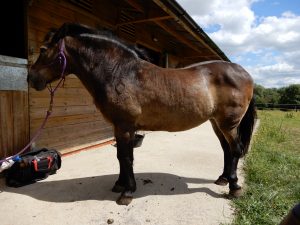
History: At first visit in July 2019, the pony had a history of several laminitis attacks with rotation over the past 4 years, but none that anyone was aware of in the last 12 months. The owner was particularly concerned by hoof wall defects – “seedy toe”1 in the toes of the left hind and right fore feet that weren’t improving. The cracks had previously been treated with iodine and the owner had transferred to using an antimicrobial hoof balm.
Along with the hoof issues, the pony had a body condition score of 4/5 with a very large cresty neck and was very itchy with “sweet itch”.
Diet wise, the pony had controlled access to grass, with some hay, and a daily bucket feed of an organic grass chaff, and approximately half of the recommended daily amount of a “feed balancer” (a product designed to supply vitamins, minerals and protein to horses on a restricted diet).
Protocol: During the first visit, the EP found long toes, wall flaring and some wall height.
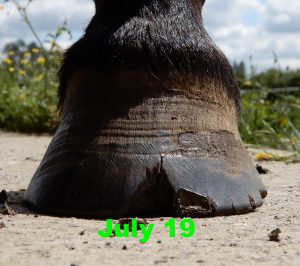 |
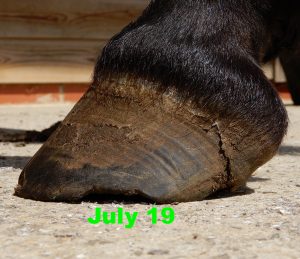 |
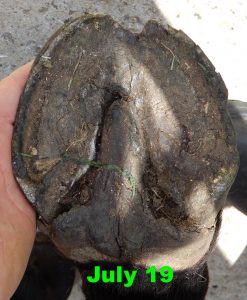 |
The feet were trimmed to reduce the forward length and excess height of the walls and reduce strain on the cracks that were opening up in the toes.
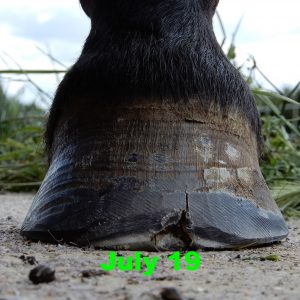 |
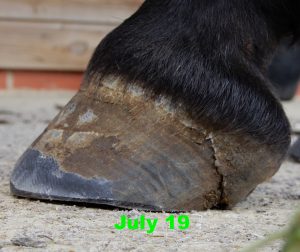 |
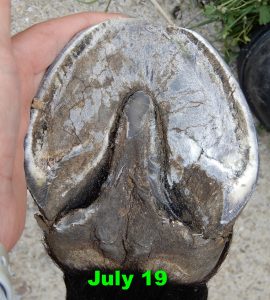 |
The EP was happy for the owner to continue using the antimicrobial balm as a topical application and suggested a small tweak to the diet, replacing the feed balancer with an alternative product designed to counteract the known deficiencies in forage in her part of the country.
By the second visit 6 weeks later, the owner had changed to the new mineral product. The pony had lost a small amount of fat in the crest and around the rib cage. However, the defects in the hoof wall were still significant and the EP decided after the trim to pack them with a proprietary product containing cotton fibres, honey and zinc oxide. This packing stays in the defect well and prevents debris damaging the hole further.
Over the next several visits the pony’s shape improved greatly, her crest measurably reduced, the fat pads on her body reduced, her coat improved, and she became less itchy. The hoof wall defects reduced slowly but reappeared a couple of times. They were treated 1-2 times weekly with the antimicrobial balm and whenever the defect was large enough to pack, at each visit were packed with the cotton, honey and zinc oxide mix by the EP. At each visit the EP worked to reduce leverage on the hoof wall that could cause the crack to pop open.
In February 2021, the diet was tweaked further by swapping onto a different forage balancer. This is when things really started to improve, including a noticeable change in hoof wall connection, with considerably less flaring in the new growth.
By April 2021 there was just a very small defect in the hoof walls
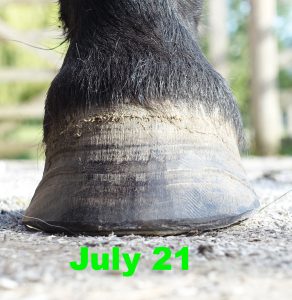 |
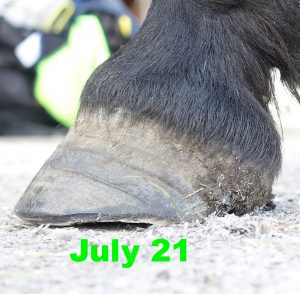 |
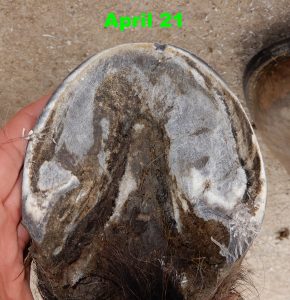 |
and by July 2021 the damage had completely gone. 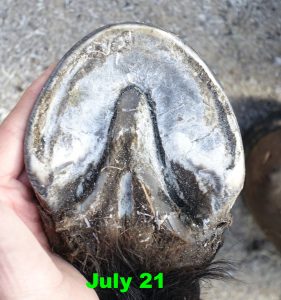 The crest that had always been extremely full and hard was much reduced, with just a small hard area right in the middle of the neck. At time of writing (February 2022) there has been no recurrence of the seedy toe.
The crest that had always been extremely full and hard was much reduced, with just a small hard area right in the middle of the neck. At time of writing (February 2022) there has been no recurrence of the seedy toe.
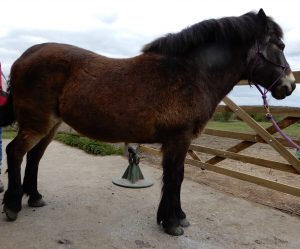
Case Study submitted by Vikki Fear
Note: 1 Seedy Toe is defined in Hickman’s Farriery (2nd Ed 1988) as “…[a] separation of the horn and sensitive laminae at the toe to form a cavity which opens at the white zone and is filled with crumbing and mealy type of horn.”